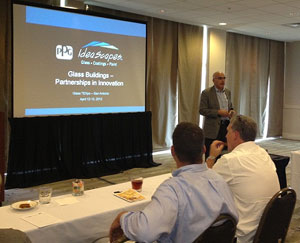May 1 2012
Glass is vital to buildings, but glass technology is vital to “green” buildings – that was the message from Mehran Arbab, PPG Industries director of research and technology, glass and fiber glass, to an audience of more than 300 industry professionals gathered on April 12 at GLASS TEXPO(TM) 2012, the annual trade show of the Texas Glass Association, in San Antonio.
 Mehran Arbab, PPG Industries director of research and technology, glass and fiber glass, delivered the keynote address, “Glass Buildings - Partnerships in Innovation,” at GLASS TEXPO(TM) 2012 in San Antonio, Texas.
Mehran Arbab, PPG Industries director of research and technology, glass and fiber glass, delivered the keynote address, “Glass Buildings - Partnerships in Innovation,” at GLASS TEXPO(TM) 2012 in San Antonio, Texas.
In his keynote address entitled "Glass Buildings - Partnerships in Innovation," Arbab discussed how innovation in four glass-related technology platforms will be critical to helping buildings, which now consume nearly 40 percent of U.S. energy output, achieve the goal of becoming energy-neutral by 2030.
- Low-emissivity (low-e) glass – These advanced high-performance coated glasses help buildings and homes conserve energy by blocking solar heat and transmitting natural light, which reduces reliance on energy-intensive heating, cooling and lighting. To highlight the importance of continued innovation in low-e glass technology, Arbab cited a report from the U.S. Energy Information Administration, which said that lighting accounts for 33 percent of energy use in commercial buildings, following by heating (16 percent) and cooling (15 percent).
- Double-skin building facades – With this design, buildings are constructed with two high-performance glass walls. Together, they form a cavity between the building’s inner and outer surfaces to make regulation of temperature, ventilation and air flow less energy-intensive than it is with conventional building facades. Arbab said that, although double-skin facades are more common in Europe, they are becoming increasingly popular with architects in North America.
- Switchable glazings – Arbab said that glass manufacturers are working on variations of all major switchable glazing technologies, particularly electrochromic and thermochromic windows. He said that while development is ongoing, each may ultimately have the potential to make buildings net-zero consumers of energy. He explained that a cost-effective thermochromic option is now available.
- Organic light-emitting diode (OLED) lighting – OLEDs are made from organic materials that emit light when an electrical current is passed through them. Over the next 20 years, the U.S. Department of Energy estimates that widespread adoption of LED and OLED lighting could reduce U.S. electricity demands by 60 percent. Arbab reported that PPG is working directly with the DOE to make these technologies more effective and affordable.
In addition to these four technology platforms, Arbab said that building-integrated photovoltaic (BIPV) technology and off-site generation of solar power are glass-related technologies that may also enable buildings to become self-sustaining producers of energy.
Glass TEXpo is the annual trade show of the Texas Glass Association. It is devoted to serving the needs of owners, operators and employees of independent glass companies, enhancing services and products offered to the general public, and furthering the advancement of the glass industry in Texas and the United States.